Please Take Note: This is a review of the final game, but it might change slightly based on the success of the Kickstarter campaign. The game is being reviewed on the components and the rules provided with the understanding that “what you see is not what you might get” when the game is published. If you like what you read and want to learn more, we encourage you to visit the game publisher’s website or visit the Kickstarter campaign. Now that we have all that disclaimer junk out of the way, on with the review.
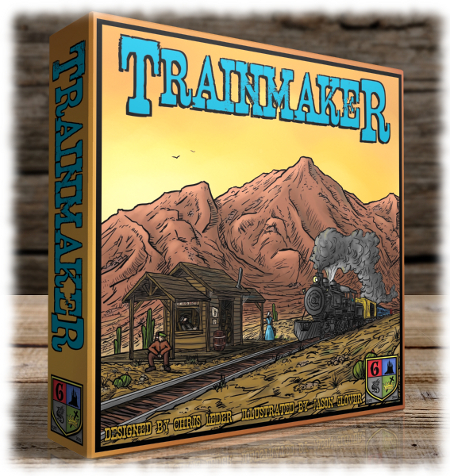
The Basics:
- For ages 5 and up (publisher suggests 8+)
- For 2 to 6 players
- Approximately 20 minutes to complete
Geek Skills:
- Counting & Math
- Logical & Critical Decision Making
- Memorization & Pattern/Color Matching
- Risk vs. Reward
- Hand/Resource Management
Learning Curve:
- Child – Easy
- Adult – Easy
Theme & Narrative:
- Build your train empire, one station at a time…
Endorsements:
- Gamer Geek mixed!
- Parent Geek approved!
- Child Geek approved!
Overview
The most fundamental concept of economics is supply and demand. One group has goods to sell and the other group has money to burn. What’s missing is the middleman who makes certain the supply reaches those who demand it. That’s where you come in. You have the money and the means to build a railroad empire. With luck and determination, you could make history.
Trainmaker, designed by Chris Leder and soon to be published by Grey Gnome Games, is comprised of 7 six-sided custom Train dice, 40 Station cards, 12 Contract cards, 2 Reference cards, and 6 Switch Track tokens. The illustrations by Jason Glover and Chris Leder do a good job of capturing the game’s theme. The use of symbols keeps the amount of information presented on each card clean and easy to understand without the need to read.
Clearing the Tracks
To set up the game, first shuffle the Contract cards and deal 2 to each player, face-down. Players review their 2 cards, select 1 to keep, and discard the other. The Contract card that is kept should be placed in front of the player, face-down. The discarded Contract cards and the remaining Contract cards not dealt should be placed back in the game box.
Second, shuffle the Station cards and place the pile face-down in the middle of the playing area. This is the Station draw deck for the duration of the game. Draw the first 3 cards from the Station draw deck and place them in a row face-up.
Third, give each player 1 Switch Track token. Place any that are not used back in the game box.
That’s it for game set up. Place the 2 Reference cards where everyone can see them. Determine who should be the first player and begin.
Trains, Goods, and Lucrative Contracts
Trainmaker doesn’t put you in the driver’s seat of a steaming locomotive. The game puts you in a far more intimidating chair. Specifically, the owner of an up-and-coming railroad business. Since you own the company, you get to make all the hard decisions, but not in a vacuum. The player’s engineers will go wherever the player directs them, but the goal is to always turn a profit by collecting goods. Before any player starts sending telegraphs and ordering goods to be shipped, they need to understand the basics, the risks, and the many ways to get rewards.
Train Dice
Each of the custom six-sided dice has 2 black “Engines”, 1 blue “Passenger Car”, 1 yellow “Boxcar”, 1 green “Flatcar”, and 1 red “Caboose”. These make up the different train parts the player will use to construct their train and haul goods. Two of the parts, the “Engine” and the “Caboose”, are essential, as a player cannot start or end their train without them. The “Passenger Car”, “Boxcar” and “Flatcar”, which are collectively referred to as “rolling stock”, are needed but may not be necessary to the player on their turn.
When the dice are all rolled and put together, the player might be able to complete a train with an “Engine”, profitable rolling stock, and the “Caboose”.

- “Engine”
- “Passenger Cars”
- “Flatcar”
- “Boxcars”
- “Caboose”
Station Cards
Scattered across the United States are railroad stations. Some are small and nothing more than a dusty platform out in the middle of a field. Others are large terminals with many different tracks entering and exiting. Station cards hold goods that must be picked up and delivered. Goods include “Passengers”, “Cattle”, “Mail”, “Coal”, “Corn”, and “Timber”. Each good can only be transferred safely using a train comprised of specific rolling stock. Using the Train dice, the player will be attempting to create a train that includes the required rolling stock listed on the Station card. If they can, the goods provided by the Station card are theirs to claim.
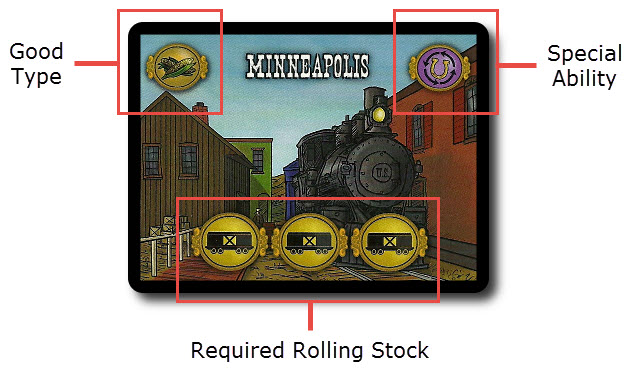
Some Station cards provide the player with a one-time special ability that can benefit the player. However, doing so forces the player to permanently discard the Station card from play. The abilities are summarized here.
- Discard Station card to change any 1 Train die to the “Boxcar” side.
- Discard Station card to change any 1 Train die to the “Flatcar” side.
- Discard Station card to change any 1 Train die to the “Passenger Car” side.
- Discard Station card to re-roll any number of dice, including those already part of a train.
While each Station card will provide only 1 type of good, the most difficult to claim Station cards let the player who claims it decide which good type is collected. This is indicated with a “?” symbol, which is also universally recognized within the game as a “wild”. However, the player cannot use the Station card for a special ability, as none is provided.
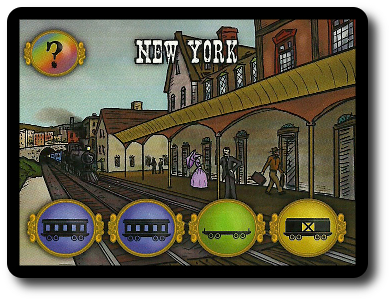
Likewise, Station cards that are very easy to claim do not provide the player with a special ability, but might still be desirable for the good type they provide. Caution, however, should be taken if the player claims it. Since the Station card only provides the good type shown, opponents now know what the player is interested in. Or, if the player is clever and doesn’t mind using a turn to collect a Station card they don’t need, they can claim it as a bluff.
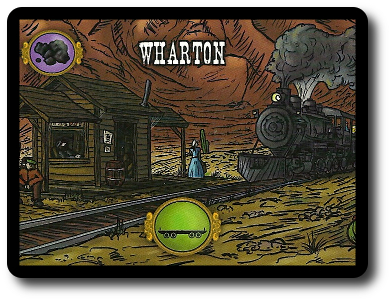
Contract Cards
Each player is given a Contract card at the beginning of the game. This is kept secret and describes what goods the player must collect in order to fulfill the contract. Keeping the Contract card a secret is a good idea for two very important reasons. First, the Contract card can by used by opponents to sabotage attempts to collect certain goods provided by Station cards. Second, if the player is able to fulfill their Contract card before any other player, they win the game.
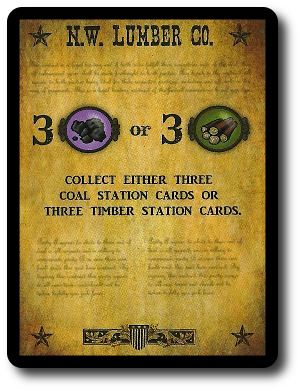
All Aboard!
Trainmaker is played in turns with no set number of turns per game. A player’s turn is summarized here.
Step 1: Roll the Train Dice
Every player’s turn starts (and potentially ends) by rolling all 7 of the Train dice. Upon rolling all 7 Train dice, the player must set aside at least 1 “Engine” and at least 1 rolling stock of the player’s choice. This is the start of the player’s train. The player can also place a second “Engine” at this time. This locks the second “Engine” as part of the train, but gives the player a Double Engine Bonus turn. The player can also, if they like, end their train by placing a “Caboose” at the end. Regardless of what the player does, trains are always built from left-to-right.
After the first roll and placement of at least 1 “Engine” and 1 rolling stock, and only if the player hasn’t placed the “Caboose”, the player can take any unplaced dice and roll again. After the re-roll, the player again must place a die, but only 1 is required. This continues until the player places a “Caboose” or derails.
“Derailing” is the game term used to indicate that the player is unable to create a train using the dice or place a die to an existing train after a roll. A player can derail after their very first roll of their turn and anytime during this step of the game if they push their luck too hard or are simply unlucky.
Maybe.
A player can tempt fate all they like, but they also have a few tricks up their sleeve that bypasses luck and gives the player a second chance.
- After rolling the Train dice, a player can permanently discard their Switch Track token to change any 1 unplaced Train dice to the value they want and add it to their train.
- Discard a Station card for its special ability after rolling the dice.
Step 2: Claim Station Cards
If the player was able to create a complete train with an “Engine”, rolling stock, and a “Caboose”, they can match the rolling stock on the Train dice with the required rolling stock on the face-up Station card. A train must have the type and number of required rolling stock shown, but not in the order in which it’s provided. A train can also contain additional rolling stock not required. Any Station card with a “?” listing a rolling stock type can be fulfilled by any rolling stock type rolled by the player.
If the player does, they claim the Station card and place it in front of them. The rules do not specify if the Station card should be placed face-up or face-down. I suggest you let players hide what they earn. This introduces the need for memorization and provides the player the ability to bluff a bit in the game.
After securing the station for their company, they also gain access to the Station card’s good type shown on the Station card. If this is a good type necessary to complete the player’s Contract card, they are one step closer to winning the game.
Step 3: Double Engine Bonus
If the player placed a second “Engine” when they first rolled, they can now take all the dice in the train (from “Engine” to “Caboose”) and start a bonus turn in an attempt to claim another Station card. Any Train dice not used in the train when the “Caboose” was placed cannot be used. The rules suggest you pass the Train dice that cannot be used to the next player in the turn order sequence, which is a very good idea.
The rules for rolling the Double Engine Bonus are the same as the first roll of the player’s turn. If the player likes, they can place a second “Engine” again giving them a third and final Double Engine Bonus. However, if a player derails, their turn ends. They will not lose any Station cards they have already claimed.
Step 4: Draw New Stations
If there are fewer than 3 Station cards visible, draw as many as necessary to bring the total to 3 face-up Station cards.
This completes the player’s turn. The next player in turn order sequence now goes, taking the dice, and trying their hand at running a railroad company.
Becoming a Railroad Barron
The game continues with players taking turns until either of the following victory conditions occur during the active player’s turn.
- The player collects enough Station card so they have 1 of each good type (this will require the player to collect at least 6 Station cards).
- The player fulfills their Contract card.
House Rules
Players are welcome to place the Station cards they have won and their Contract card face-up if they want to. I personally think the game is better when such information is hidden, but not when playing with younger Child Geeks. If you keep the cards face-up, Child Geeks as young as 5-years-old can easily play the game with just a little bit of help from more experienced gamers. The only help required is reminding them to look at their Station cards. This is why the cards are face-up, so as to easily assist without interrupting the game’s speed. Give it a try with your youngest players. Once they get the hang of the game, flip the cards face-down.
To learn more about Trainmaker, visit the game publisher’s website or visit the Kickstarter campaign.
Final Word
The Child Geeks had no issues grasping the game’s goals and the risk versus reward game play. They used their Contract cards as a guide, but not once did I observe any of the Child Geeks using it as their only means to achieve victory. According to one Child Geek, “The Contract card gives you a goal, but I think it’s easier if you attempt to collect one of each good type.” When it came to the dice rolling, the Child Geeks liked how the train was built in front of them, getting longer and longer, until they either derailed it or ended it with a Caboose. One Child Geek said, “It’s easy to see what you need on the Station cards and what you have on the dice. I only wish it was as easy to roll the Caboose!” Oddly enough, a few of the Child Geeks never seemed to roll the Caboose when they wanted to, which lead to some speculation that a few of the dice were “broken”. Which, of course, is not true, but try telling that to a Child Geek who just derailed their fifth train in a row. What never derailed was the enthusiasm and fun, resulting in all the Child Geeks fully approving Trainmaker.
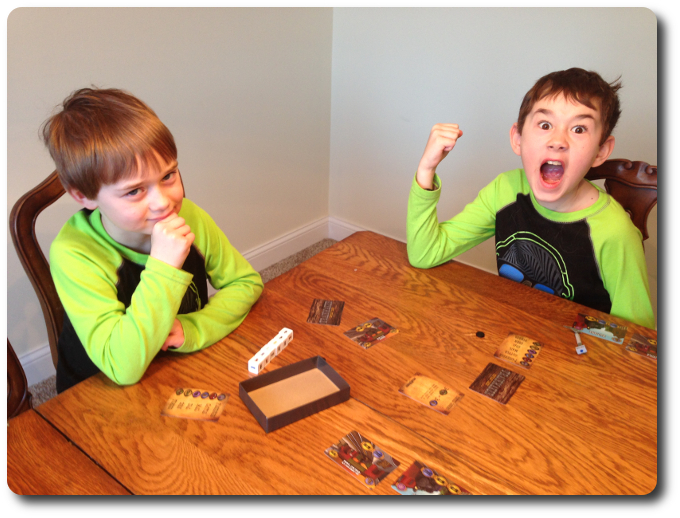
One of my little geeks makes rolling trains look easy, much to the chagrin of his older brother…
The Parent Geeks found Trainmaker to be light and casual, perfect for playing with their family and with other adults after a meal or when drinking coffee. They thought the game was a bit too big (component wise) to bring to a restaurant, but it was perfect for small gatherings. One Parent Geek said, “This is a very simple game to learn and an easy game to play. You have to push your luck, but you always have options which means you don’t have to push your luck any further than what you want. I like that.” Another Parent Geek said, “If you push your luck, there are real rewards to be had. The more Station cards you can grab on your turn, the better off you are. Double Engine Bonus for the win!” The only aspect of the game the Parent geeks didn’t use much was the Station cards special abilities. Not because they weren’t useful, but because they seldom needed them. As one Parent geek put it, “I usually am happy with what I roll. I guess the only special ability I would have liked to have seen is the option to remove and redraw the available Station cards.” The Parent Geeks would have also liked to have had the game go a bit longer. A few even suggested that 2 or more Contract cards were in order, which was not a popular notion. What was popular was the game with all the Parent Geeks approving it family and friends.
The Gamer Geeks were mixed when it came to Trainmaker. One Gamer Geek said, “This is a total luck fest. Roll the dice, hope for the best, and grab a card that you might or might not need.” When I pointed out that every Station card provides a special ability which makes it useful, he corrected me by saying, “Might be useful, Cyrus. Might be.” Fair enough, but with one of the two victory conditions requiring 1 of each good type, a number of the Gamer Geeks found it beneficial to collect a Station card that their Contract card didn’t specifically require. According to one of these Gamer Geeks, “I like that there are two paths to victory. One short and one long. The longer of the two, claiming 1 of each good type, will take a player longer to collect but they have more options available to them. The Contract cards are shorter, but require specific cards which will force the player to hunt them down and be picky. That’s a fun little twist.” None of the Gamer Geeks found Trainmaker to be a bad game, but they were undecided when it came time to determine if Trainmaker was a “Gamer Geek’s game”. Half of the Gamer Geeks said it was, being a fun and casual game that required light critical thinking and some hand management. This half believed Trainmaker would be good fun as a filler or just as a casual game to start an evening of heavier games. The other half found Trainmaker to be too simple, comprised of nothing but luck, and lacked player interaction. The end result was a mixed level of approval from the gaming elitists.
I had an opportunity to first play this game with the game designer at Gen Con some years ago. I remember liking the game then and I still like it today. It can be a bit frustrating at times, especially when you do not roll the values you need or a player grabs a Station card you want right before your turn. Even worse is the intense feeling of injustice you get when an opponent wins the game with your own victory easily at hand on your next turn. But that’s the game and it shouldn’t be taken so seriously as to cause anyone stress. Luck plays a roll but can be offset with special abilities and proper use of the Switch Track token. Other than that, a player can only make choices based on what has been rolled.
Trainmaker left half of our Gamer Geeks feeling cold and uninterested. Everyone else found the game to be light, fun, and fast. Perfect for an easy game night or a filler between more difficult games. I agree. It’s not a game I would want to play with serious gamers who want to sink their teeth into a game that provides immersive game play, strategy, and tactical decision making. This is not that kind of game. What it lacks in depth it makes up for by challenging the player to do some critical thinking. That’s enough for a light game to keep me engaged. If the game sounds like a good fit for you, your family, and your friends, do sit down and ride this train.
This game was given to Father Geek as a review copy. Father Geek was not paid, bribed, wined, dined, or threatened in vain hopes of influencing this review. Such is the statuesque and legendary integrity of Father Geek.




Thanks for the review, Cyrus! I’m glad that most of your players had a great time and might see fit to play this game as a light, fun filler. (As always, especially with games of luck and dice, I fully expected some alpha gamers not to jump for joy) 🙂
I wouldn’t worry about the gaming elitists, Chris. There are days where they judge the depth of their own character as too “shallow”.